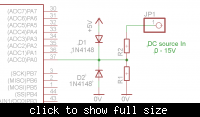yokohama
Member level 3
Hi everybody,
I'm new in avr programming, and here is my problem:
I would like to sample a dc source who varies from 0V to 15 Volts, and we know that the adc of most mcu don't accept a voltage higher than 5V. The question is how to interface this voltage to my ATmega16.
Second problem: Is it possible to isolate this dc source from the mcu like optocoupler in digital signal ?.
I'm new in avr programming, and here is my problem:
I would like to sample a dc source who varies from 0V to 15 Volts, and we know that the adc of most mcu don't accept a voltage higher than 5V. The question is how to interface this voltage to my ATmega16.
Second problem: Is it possible to isolate this dc source from the mcu like optocoupler in digital signal ?.
